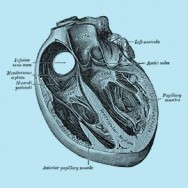
Minimally Invasive Mitral Valve Surgery (mini-Mitral)
Background
The mitral valve controls blood flow between the chambers on the left side of the heart, which pumps oxygenated blood to the body. There are two main problems that can occur with the mitral valve: it can become too narrow (stenosis), or it can leak (regurgitation). Abnormal blood flow through the valve will then cause the heart to work harder, and eventually lead to heart failure. Symptoms of this include shortness of breath, light-headedness, fatigue, chest pain or palpitations.
About the surgery
Usually the sternum (breast bone) is divided to access the heart. Alternatively, minimally-invasive mitral valve surgery can be performed through a 5-10 cm horizontal incision (called minithorocotomy) on the right side of the chest, with 3 keyhole incisions around this for instruments. These incisions are shown in Figure 1. Specialised, long instruments can be used (referred to as “mini-mitral” surgery), or alternatively a surgical robot can be used (referred to as “robotic mitral valve surgery”) that gives the surgeon an excellent 3D view and precise movements.
The surgical robot that Sydney Heart & Lung Surgeons use is called the da Vinci Surgical System (Figure 2). Not everybody is suitable for minimally-invasive mitral valve surgery, so you should discuss this with your surgeon.
Benefits of minimally invasive
The benefits of minimally-invasive mitral valve surgery:
- Smaller incisions and better cosmetic result
- Less bleeding and risk of infection
- Less pain after the operation
- Shorter hospital stay (usually 3 to 4 days)
- Faster recovery and return to work

Risks of the surgery
Minimally-invasive mitral valve surgery has similar risks to traditional open-chest mitral valve surgery, including wound infection, bleeding, kidney injury, stroke, heart attack, arrhythmias and pacemaker implantation, and possibly death. With minimally invasive surgery there is also the risk that procedure needs to be converted to the traditional open-chest method. If repair is not possible, then the valve will need to be replaced with an artificial one. This can either be a mechanical valve, or a biological one. Both have advantages and disadvantages that your surgeon will discuss with you.
For more information please visit:
Cleveland Clinic Mitral Valve Surgery
Cleveland Clinic Minimally Invasive Mitral Valve Surgery
All patients should consult their cardiothoracic surgeon for specific information about their medical condition and surgery.

